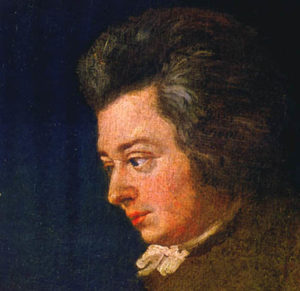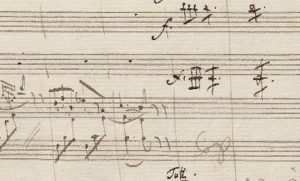
Though Mozart likely began composing his last piano concerto sometime in 1788, he would not complete it until January 1791; after composing the first two movements and 39 measures of the finale, he likely realized that his other recently written concertos would suffice for his upcoming performances and saved the unfinished work for later.
The intervening years would be difficult ones for the composer, marked by a decline in his popularity with the Viennese public, fewer compositions and financial woes. These were problems he could only compose his way out of, and when a concert opportunity presented itself, he dusted off the unfinished concerto and completed it. Mozart performed the premiere himself at a concert in Vienna on March 4, 1791, beginning a triumphant comeback. Sadly, it would be his final public appearance as a pianist, as he would die the following December at age 35 of what was then known as “acute miliary fever.”
The Music
The concerto gives no indication of Mozart’s troubles or impending fate; its formal balance and melodic beauty make it one of his most perfect masterpieces:
https://www.youtube.com/watch?v=idvrich2Tyw&t=12s
The concerto begins with an orchestral introduction that presents the four main themes of the first movement (in general, the themes are played softly while intervening transitional material is louder). The first theme is an elegant conversation between violins and woodwinds; following immediately after, the second is a lyrical melody with echoes from the flute; the third introduces a more humorous tone with its twittering figures in the violins; last is a lyrical, singing theme that occurs after the shadow of the parallel minor key passes briefly over the music.
The pianist then enters with a lightly embellished version of the first theme before digressing into a richly chromatic, minor-key episode. The pianist then similarly reinterprets the other themes, except the last; instead the minor-key shadows send the music into an exquisite developmental section. Changing key 20 times in a mere 60 measures, this development focuses on fragments of the first theme, which are overlapped and recombined with each other to great expressive effect.

The orchestra and soloist then reprise the movement’s themes—including the last one this time—leading to a cadenza, an extended solo for the soloist alone. At the premiere Mozart would have improvised the cadenza on the spot, but when he later prepared the score for publication he wrote down a version of the cadenza that other pianists could use. Mozart’s cadenza primarily revisits the second and first themes before ending with the traditional trill, a signal to the orchestra to bring the movement to a close.
The slow second movement has a simple A-B-A structure; it begins with a lovely melody introduced by the piano and then taken up by the orchestra. The pianist introduces a contrasting phrase that leads back to the beginning of the melody. The orchestra’s conclusion of the theme, however, introduces a powerful dissonance before bringing the theme to its conclusion. The contesting middle section introduces a graceful new theme that dreamily slips into a distant key, slowly winding its way back to a reprise of the opening section.
The finale begins with a cheerful theme that Mozart adapted for a song called “Yearning for Spring,” perhaps a reflection of his hopes for the future. This theme alternates with contrasting episodes, including a second cadenza, and brings the concerto to a delightful ending. —Calvin Dotsey
Don’t miss Emanuel Ax’s performances of Mozart’s Piano Concerto No. 27 on May 18, 19 & 20, 2018! Get tickets and more information at houstonsymphony.org.



